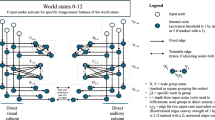Abstract
In order to understand language, a hearer must draw inferences to establish referential and causal coherence. Hence our ability to understand language suggests that we are capable of performing a wide range of inferences rapidly and spontaneously. This poses a challenge for cognitive science: How can a system of slow neuron-like elements encode a large body of knowledge and perform inferences with such speed? SHRUTI attempts to answer this question by demonstrating how a neurally plausible network can encode a large body of semantic and episodic facts, and systematic rule-like knowledge, and yet perform a range of inferences within a few hundred milliseconds. This paper describes a novel representation of types and instances in SHRUTI that supports the encoding of rules and facts involving types and quantifiers, enables SHRUTI to distinguish between hypothesized and asserted entities, and facilitates the dynamic instantiation and unification of entities during inference.
Preview
Unable to display preview. Download preview PDF.
Similar content being viewed by others
References
Ajjanagadde, V.: Reasoning with function symbols in a connectionist network. In: Proceedings of the 12th Conference of the Cognitive Science Society, Cambridge, pp. 285–292 (1990)
Ajjanagadde, V.: Abductive reasoning in connectionist networks: Incorporating variables, background knowledge, and structured explanada, Technical Report WSI 91–9. Wilhelm-Schickard Institute, University of Tubingen, Germany (1991)
Ajjanagadde, V., Shastri, L.: Efficient inference with multi-place predicates and variables in a connectionist network. In: The Proceedings of the 11th Conference of the Cognitive Science Society, Ann-Arbor, MI, pp. 396–403 (1989)
Bailey, D., Chang, N., Feldman, J., Narayanan, S.: Extending Embodied Lexical Development. In: The Proceedings of the 20th Conference of the Cognitive Science Society, Madison, WI, pp. 84–89 (1998)
Barnden, J., Srinivas, K.: Encoding Techniques for Complex Information Structu- res in Connectionist Systems. Connection Science 3(3), 269–315 (1991)
Bliss, T.V.P., Collingridge, G.L.: A synaptic model of memory: long-term potentiation in the hippocampus. Nature 361, 31–39 (1993)
Gasser, M., Colunga, E.: Where Do Relations Come From? Indiana University Cognitive Science Program, Technical Report 221 (1998)
Hobbs, J.R., Stickel, M., Appelt, D., Martin, P.: Interpretation as Abduction. Artificial Intelligence 63(1-2), 69–142 (1993)
Hummel, J.E., Holyoak, K.J.: Distributed representations of structure: a theory of analogical access and mapping. Psychological Review 104, 427–466 (1997)
Lakoff, G.: Women, Fire, and Dangerous Things – What categories reveal about the mind. University of Chicago Press, Chicago (1987)
Lange, T.E., Dyer, M.G.: High-level Inferencing in a Connectionist Network. Connection Science 1(2), 181–217 (1989)
Lisman, J.E., Idiart, M.A.P.: Storage of 7 ± 2 Short-Term Memories in Oscillatory Subcycles. Science 267, 1512–1515 (1995)
Luck, S.J., Vogel, E.K.: The capacity of visual working memory for features and conjunctions. Nature 390, 279–281 (1997)
Mani, D.R., Shastri, L.: Reflexive Reasoning with Multiple-Instantiation in a Connectionist Reasoning System with a Typed Hierarchy. Connection Science 5(3-4), 205–242 (1993)
Park, N.S., Robertson, D., Stenning, K.: An extension of the temporal synchrony approach to dynamic variable binding in a connectionist inference system. Knowledge-Based Systems 8(6), 345–358 (1995)
Regier, T.: The Human Semantic Potential: Spatial Language and Constrained Connectionism. MIT Press, Cambridge (1996)
Shastri, L.: Neurally motivated constraints on the working memory capacity of a production system for parallel processing. In: Proceedings the 14th Conference of the Cognitive Science Society, Bloomington, IN, pp. 159–164 (1992)
Shastri, L.: Exploiting temporal binding to learn relational rules within a connectionist network. TR-97-003, International Computer Science Institute, Berkeley, CA (1997)
Shastri, L.: A Model of Rapid Memory Formation in the Hippocampal System. In: Proceedings of the 19th Annual Conference of the Cognitive Science Society, pp. 680–685. Stanford University, CA (1997)
Shastri, L.: Advances in SHRUTI – A neurally motivated model of relational knowledge representation and rapid inference using temporal synchrony. Applied Intelligence 11, 79–108 (1999)
Shastri, L.: Recruitment of binding and binding-error detector circuits via longterm potentiation. Neurocomputing 26-27, 865–874 (1999)
Shastri, L., Ajjanagadde, V.: From simple associations to systematic reasoning: A connectionist encoding of rules, variables and dynamic bindings using temporal synchrony. Behavioral and Brain Sciences 16(3), 417–494 (1993)
Shastri, L., Grannes, D.J.: A connectionist treatment of negation and inconsistency. In: Proceedings of the 18th Conference of the Cognitive Science Society, San Diego, CA (1996)
Shastri, L., Grannes, D.J., Narayanan, S., Feldman, J.A.: A Connectionist Enco- ding of Schemas and Reactive Plans. In: Kraetzschmar, G.K., Palm, G. (eds.) Hybrid Information Processing in Adaptive Autonomous vehicles. LNCS, Springer, Berlin (to appear)
Shastri, L., Wendelken, C.: Knowledge Fusion in the Large – taking a cue from the brain. In: Proceedings of the Second International Conference on Information Fusion, FUSION 1999, Sunnyvale, CA, July 1999, pp. 1262–1269 (1999)
Singer, W.: Synchronization of cortical activity and its putative role in information processing and learning. Annual Review of Physiology 55, 349–374 (1993)
Sun, R.: On variable binding in connectionist networks. Connection Science 4(2), 93–124 (1992)
von der Malsburg, C.: Am I thinking assemblies? In: Palm, G., Aertsen., A. (eds.) Brain Theory. Springer, Heidelberg (1986)
Author information
Authors and Affiliations
Editor information
Editors and Affiliations
Rights and permissions
Copyright information
© 2000 Springer-Verlag Berlin Heidelberg
About this paper
Cite this paper
Shastri, L. (2000). Types and Quantifiers in SHRUTI – A Connectionist Model of Rapid Reasoning and Relational Processing. In: Wermter, S., Sun, R. (eds) Hybrid Neural Systems. Hybrid Neural Systems 1998. Lecture Notes in Computer Science(), vol 1778. Springer, Berlin, Heidelberg. https://doi.org/10.1007/10719871_3
Download citation
DOI: https://doi.org/10.1007/10719871_3
Publisher Name: Springer, Berlin, Heidelberg
Print ISBN: 978-3-540-67305-7
Online ISBN: 978-3-540-46417-4
eBook Packages: Springer Book Archive




